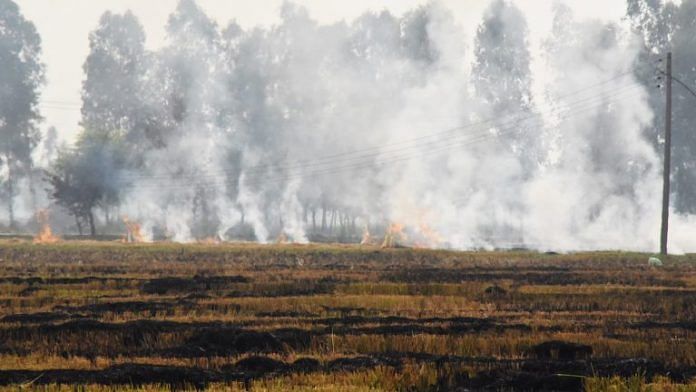New Delhi: Stubble burning cases in Punjab have increased by over 44 per cent this year compared to 2019, according to a report submitted to the Supreme Court by the Centre.
The report also said stubble burning has come down by 25 per cent in Haryana in 2020.
The detailed comparative analysis for 2019-2020 is part of the Centre’s affidavit that it filed Wednesday in response to the top court’s direction to enlist the steps taken by the Commission for Air Quality Management (CAQM), constituted to tackle air pollution in the National Capital Region (NCR).
After this commission was set up in October, the central government had dissolved the decades-old Supreme Court-constituted Environment Protection Control Authority (EPCA).
On the steps taken by the newly-established commission, the Centre submitted details of the meetings convened to review measures and deliberate on proposals regarding steps that need to be taken to improve the air quality of Delhi-NCR.
It said the commission has taken inputs from various stakeholders, including NGOs, on measures that can be taken to mitigate paddy residue burning.
Contribution of stubble burning this year to Delhi’s PM levels was 42%
In Punjab, there are six districts that continue to be highest contributor to stubble burning, said the report. These are Sangrur, Bathinda, Ferozepur, Moga, Ludhiana and Mukstar.
All six have seen an increase in stubble burning incidents since 2019. In Sangrur, there was a spike of 45 per cent. Bathinda fires surged by 34 per cent, while Ferozepur incidents went up by 38 per cent this year. Moga, Ludhiana and Fazilka districts have recorded more than 70 per cent increase in active stubble burning incidents.
According to the System of Air Quality and Weather Forecasting and Research (SAFAR) model of Indian Institute of Tropical Meteorology, the estimated maximum contribution of stubble burning to PM levels in Delhi between October and December was 25 per cent, 36 per cent and 44 per cent in 2017, 2018 and 2019, respectively.
In 2020, the contribution level so far has been 42 per cent, the report said.
Also read: We burn stubble ‘out of desperation’ because govt hasn’t found solutions, Punjab farmers say
Commission for e-mobility, strengthening regime of PUC certificate
Since its constitution, the Commission for Air Quality Management has so far met thrice, the Centre told the court, adding that it held a meeting with ICAR scientists and ISRO officials to discuss crop forecasting techniques.
Promotion of e-mobility and zero emission vehicles, strengthening the regime of pollution under control (PUC) certificate, developing yardsticks for use of anti-smog guns at construction sites and expeditious conversion of industrial units to cleaner fuels are some of the suitable interventions and action points that were identified during the review meets.
Besides, the commission has also constituted sub-committees on ‘monitoring and identification’ and ‘safeguarding and enforcement’ as mandated in the ordinance, the Centre’s affidavit disclosed.
Work is also in progress for the development of a Decision Support System (DSS) for air quality emergence response activities involving resource persons from institutions such as IIT Delhi, IMD, IITM, NEERI, TERI and C-DAC.
Also read: Pusa tablets — the microbial cocktail that gives farmers an alternative to stubble burning




What’s the point of these studies. Farmers who burn stubble demanded exemption from punishment from the central government during the farmers protests, which was been accepted. Who cares about the environment and breathable air.
How do all these studies matter. The farmers burning the stubble demanded that they be exempted from any punishment for it, and it has been granted by the central government during the farmers protests. Who cares for environment and breathable air.